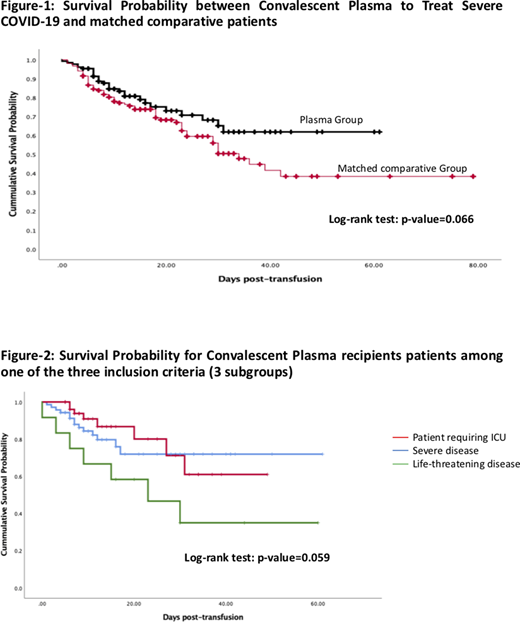
Introduction
Coronavirus disease (COVID-19) pandemic has started to affect Saudi Arabia in the beginning of March 2020 and is expected to cause significant morbidity to many patients, especially to elderly, who might require intensive care unit (ICU) support to survive as its lethality increases with the increasing age. Recent publications suggested the benefit of utilizing convalescent plasma from recovered donors as a therapeutic approach in treating COVID-19 patients. Convalescent plasma could provide our first-line defense for people with COVID-19, especially those who are older and at a much higher risk for complications., therefore, we developed a national protocol to investigate the safety, benefit and applicability at larger scale and at different health care facilities in Saudi Arabia (KSA).
Objectives
Primary endpoints are
1. ICU (or designated area for critical patients) length of stay
2. Safety of convalescent plasma>
Secondary endpoints included:
1. 30 days mortality
2. Number of days on mechanical ventilation
3. Days to clinical recovery
Method
Eligible convalescent plasma donors will be invited to participate in trial. The arrangement for plasmapheresis will start after obtaining donor informed consent. The collected plasma will be treated with pathogen reduction system. The convalescent plasma units will be labelled, stored and shipped as per the standard transfusion medicine protocols. It will be used only for eligible patients' "recipients" as per the following eligibility criteria:
1. Inclusion criteria:
- Confirmed case of SARS-CoV-2 infection with POSITIVE rRT PCR test
-18 or older
-Must have been requiring ICU care or severe or immediately life-threatening care (any one of the following):
1. Patient requiring ICU care/admission.
2. Severe disease is defined as:
a. Dyspnea
b. Respiratory frequency ≥ 30/min
c. Blood oxygen saturation ≤ 93%
d. Partial pressure of arterial oxygen to fraction of inspired oxygen ratio < 300, and/or Lung infiltrates > 50% within 24 to 48 hours
3. Life-threatening disease is defined as:
a. Respiratory failure
b. Septic shock, and/or
c.Multiple organ dysfunction or failure
Exclusion criteria:
1. Negative or non-conclusive test COVID-19 rRT PCR test
2. Mild symptoms
3. Hospitalization not requiring ICU care/admission
Eligible Patients will be infused with the convalescent plasma (200-400 ml / treatment dose)at least once & if possible, daily, for up to 5 sessions. Other supportive and therapeutic measures should continue according to the locally approved protocols with due diligence.
Sample size was calculated with 80% power and 5% level of significance based on the recently published data to detect statistical difference in the study outcome. Therefore, we plan to recruit total of 575 patients.
Convalescent plasma Recipient Group: 115 patients (recipients) who have COVID 19 as per the inclusion criteria.
Comparative control Group: 460 Patients who are eitherCOVID 19 historical control or only consent for sharing their clinical and laboratory data
Matching for age, gender, Hypertension, Diabetes and intubation status were done based on the propensity score. Continuous variables will be presented as the median and interquartile range (IQR). Statistical software SPSS 24.0 will be used. Demographic, Clinical, imaging and laboratory information of all enrolled patients will be retrieved from the hospital electronic/paper records system to be used for the outcomes analysis.
Results
22 sites across KSA that participated in the study. Tertiary, secondary, academic and non-academic centers participated (real world data). There were no unusual safety issues related to convalescent plasma infusion since all mortalities in the plasma group were not related to plasma infusion which represent similar finding from other the published international reports. Keeping in-mind that our data is still maturing, 30 survival probability in the plasma group was 69% compared to 56% in the comparative group (p value = 0.066) (figure-1). This benefit to seem to be more noticeable in the COVID-19 cases who did not meet the criteria for life-threatening disease (figure-2).
Conclusion
Our study supports the safety of convalescent plasma in treating COVID-19 patients. Patients who are in the category of life-threating/end organs failure do not seem to benefit. There might be a benefit in the other subgroups.
No relevant conflicts of interest to declare.
Author notes
Asterisk with author names denotes non-ASH members.

This icon denotes a clinically relevant abstract


